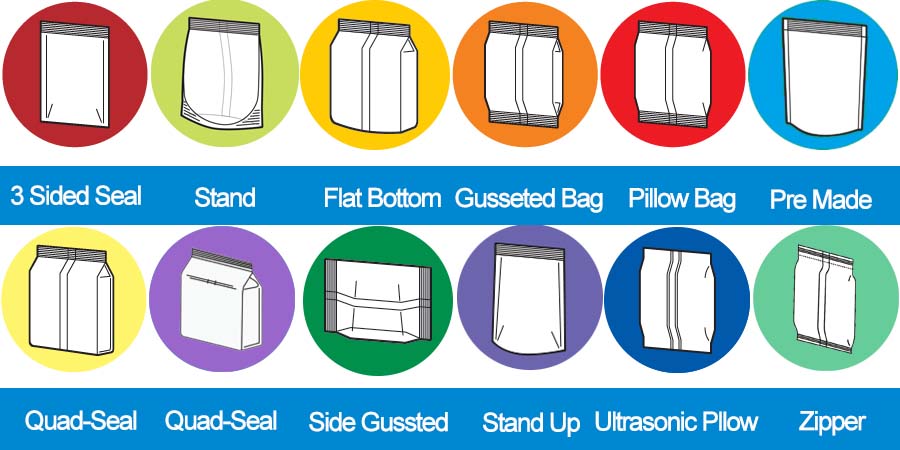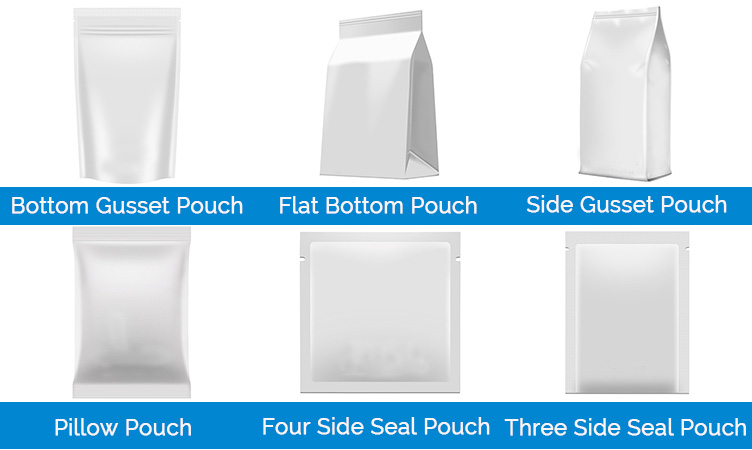What is Flexible Packaging?
Flexible packaging: a general term for products that are packaged with flexible materials. Flexible packages can be made from paper, plastic, film, aluminum foil, or any combination of those materials. Packaging styles are not limited to pouches, bags, liners, wraps, and more.
How Flexible Packaging Is Made?
Plate Making
The plate making process is the process of manufacturing a printing plate that transfers ink to the printing material during printing. Through the dots made on the printing plate, the color of the original image is reproduced.
Printing
The printing process is the process of using substrates, printing plates, inks, and printing machinery to achieve graphic reproduction. The graphics and text on the printing plate will be transferred to the substrate.
According to the types of printing plates: gravure, flexo, silk-screen, letterpress, and offset printing methods.
Most flexible packaging is produced by gravure printing process. During production, the printing material is discharged into the printing device through the unwinding device, the ink on the surface of the printing plate is scraped off by the scraper, and the ink in the dots is transferred to the printing material when the printing material is pressed down. After entering the oven, the solvent components in the ink volatilize in the heated and blown oven. When the printed film passes through the cooling roller after coming out of the oven, it is cooled and shaped. In multi-color printing, the computer automatic overprinting device controls overprinting between colors. After the printing is completed, the winding device winds the printed product into a roll film.
Quality Inspection
The quality inspection process is a process in which the printed semi-finished products are checked out and rejected by the quality inspection machine. Reduce the production loss in the subsequent process and the difficulty of quality inspection.
Compounding
The compounding process is to combine two or more materials together to form an integrated material. Composite materials can not only maintain the excellent characteristics of single-layer materials, but also overcome their respective shortcomings. After composite, they have new characteristics and meet the different requirements of food and other commodities for composite materials.
Classification of compound: dry compound method, wet compound method, extrusion compound method, solvent-free compound method, hot melt compound method, co-extrusion compound method.

Most of the flexible packaging is produced by the dry compounding process. During production, the glued substrate is discharged into the gluing device through the unwinding device. The glue on the surface of the glue roller is scraped off by the scraper, and the glue in the dots is on the glued substrate. When the pressing occurs, it is transferred to the surface of the glued substrate, and then enters the oven. The solvent component in the glue is volatilized in the heated and blown oven. After coming out of the oven, it is integrated with the substrate released by another unwinding device in the heated and pressurized composite nip roller. After cooling and shaping, it is wound into a roll-like composite film by a winding device.
Curing Process
The curing process is a process in which the main agent and curing agent in the composite film complete the reaction. The newly compounded composite product cannot enter the next process because the adhesive layer is not cured and set. Therefore, the main agent and curing agent must be cured through the curing process to complete the reaction of the main agent and the curing agent, and the adhesive layer is set. The maturation is divided into room temperature maturation and heating maturation. Normal temperature curing means that the composite film completes the reaction between the main agent and the curing agent at room temperature; heating curing is the composite film completing the reaction between the main agent and the curing agent at a specific temperature. Heating and curing can speed up the reaction between the main agent and the curing agent and shorten the production cycle.
Slitting
Slitting is the process of slitting the laminated composite film or the printed film that does not need to be composited into the required width. During production, the slitting material is discharged through the unwinding device, and the photoelectric control system controls the longitudinal travel position of the slitting material to keep the cutting knife position of the slitting product constant. The winding device winds the cut product into a roll film. Some of the slit product roll film is used as a finished product for the customer’s automatic packaging machine, like pre-made pouch machine, and some is used as a semi-finished product and transferred to the next process for bag making.
Bag Making
The bag-making process is a process of heat-sealing the composite film into a bag shape according to customers’ requirements. The inner layer of the composite film must be a film with heat-sealing properties.
The flexible packaging bag making process is divided into two types: back-seal bag-making and side-seal bag-making. The back-seal bag-making method is a split type, and the bag is formed by pressing the palms together and then cutting the bag to complete the bag-making.
During production, after the bag-making material is discharged by the unwinding device, it enters the forming stage, which is mainly completed by the photoelectric control system, the forming plate, and the adjusting device. The bag-making material enters the heat-sealing stage, and the longitudinal and transverse heat-sealing devices complete the heat-sealing of the bag, and the part that has just been heat-sealed is cooled and shaped, and then the photoelectric control system controls the delivery position of the heat-sealed material. The cutter device cuts the continuous bag material sent out into individual bags.
Common Bag Shapes
- Middle-sealed bag
- Middle-sealed organ bag
- Trapezoidal middle-sealed organ bag
- Side sealing organ bag
- Four-side sealing organ bag
- Three-side sealing bag
- Self-supporting bag
- Three-side sealing zipper bag
- Self-supporting zipper bag
- Penguin bag
- Tear mouth bag
- Bag in box

What Are Flexible Packaging Materials?
- Paper and plastic film
- Plastic film and plastic film
- Plastic film and metal foil
- Plastic film and metal film
- Plastic film and base material
- Plastic film and inorganic compound film
- Plastic film and organic compound film
- Amorphous plastic film and plastic film
- Composite of base material and nano ultrafine particles
- Special additives for substrate coating or dipping
- Multi-layer composite of composite materials, etc.
Types of Flexible Packaging
There are two types of flexible packaging, namely stretch wrap packaging and various bags. Twist packaging is composed of a plastic film that has not yet formed a packaging shape. The film is simply wound on one or more products to be packaged and fixed in place in some form. The plastic bag is made into a certain shape before the product is put in or while the product is put in. The most common is to heat seal the plastic edge to form this shape.
Twister Packaging
One of the biggest applications of plastic film in packaging is twister packaging, which binds the goods on the pallet together to make them integrated and enter the circulation.
Shrink Packaging
Shrink packaging is an alternative to twist packaging. When the shrink wrapping is exposed to a heat source, the originally aligned (orientated) molecules try to return to a lower energy, unstretched random coil structure. The product prevents the film from returning to its unstretched size, and the material acts on the product. strives to bind the goods.

In order to bundle goods on pallets, stretch wrap packaging is more common than shrink packaging because it requires less energy and is more economical. Shrink packaging is more commonly used as a bundled packaging, which bundles two or several products (same or different), rather than a full pallet of goods.
Shrink packaging is often used for product protection rather than bundling, in applications ranging from food, beverages, toys, and pharmaceuticals. It can wrap the entire product tightly, preventing dirt, moisture and abrasion. Usually, the film is made into a loose bag before the film is tightly shrunk to the product in the shrink tunnel. LDPE and LLDPE are commonly used materials for shrink films. PVC and PP is less used, as are some special films.
Bag, Sack and Flexible Packaging Pouches
The production of bags, sack and pouch is to seal two or more sides of a plastic film together to form a cavity for holding products. In most applications, the opening is then sealed in order to make the product completely encapsulated by the packaging material. Sometimes, the side of the bag is open.
You may get confused by the bag, sack, and pouch, here is the clarification: bag and sack is a package with an open top, while pouch is much smaller package that is completely sealed.
Common pouch include pillow-shaped bags, three-sided sealed bags and four-sided sealed bags. Pillow pouches are made of plastic film into a cylinder, and then the sides are sealed together, and the sealed sides become the back seams of the finished package. Clamp and seal the bottom of the cylinder, put the product in, and add the top seam. After being filled with products, it looks like a pillow–that’s the origin of the name.
The three-side sealed bag is made by folding the film into a rectangle and sealing the three unfolded sides. The four-side sealed bag is made of two sheets of film, and all sides are sealed together. Therefore, the four-sided sealed bag does not have to be rectangular. Contrary to pillow bags and three-sided sealed bags, different plastic films can be used on the front and back of the four-sided sealed bags.
The pouch can be used alone or together with other packaging for product circulation and distribution. A very common packaging structure is bag-in-box packaging, place the sealed bag in a folded carton or corrugated box by the packaging machinery like cartoning machine.
The material of the bag can be all plastic films, or multi-layer materials containing paper or aluminum foil. Paper can be used to increase the strength, hardness, printability and apparent density of flexible packaging. Aluminum foil can be added to improve its permeability to oxygen, water vapor, odor, aroma and other permeates.
What Machines Are Used to Package?
Flexible Packaging Machine
There are two main ways to use bags, sacks, and pouches for packaging: as premade pouch or used in forming-filling-sealing production. In form-fill-seal (FFS) production, the substrate is added to a horizontal or vertical FFS machine to form a bag, then the product is filled in, and finally sealed . If a premade pouch is used, make the bag first, leaving a mouth for the product. In the following production, the product is filled into the bag, and then the bag is sealed.
From an economic point of view, form-fill-seal has advantages in mass production . If the output is low or the material is difficult to seal, or there are problems with quality control, it is generally more economical to buy pre-made bags.
We are going to introduce these two kinds of flexible packaging machine for you.
Premade Pouch Packing Machine
The premade pouch filling machine usually consists of two parts: a pouch-feeding machine and a weighing machine. The weighing machine can be a weighing type or a screw type, and both granules and powder materials can be packaged.
The working principle of premade pouch filler machine is to use the manipulator to take, open, cover and seal the premade pouches, and at the same time complete the functions of filling and coding under the coordinated control of the microcomputer, so as to realize the automatic packaging of the bags. It is widely used in food, agriculture, medicine and other industries.
1. Why Choose Pouch Packing Machine?
Its characteristic is that the manipulator replaces manual bagging, which can effectively reduce the bacterial contamination in the packaging process
Replace traditional manual packaging with premade pouch packaging machines, realize the automation of product packaging, improve enterprise production efficiency, and greatly reduce product costs
The packaging range of premade pouch filling sealing machine is wide. Choose different metering and filling devices according to different packaging materials to pack various solid materials, liquids, sauces, powders, granules and other materials. Suitable for small-size and large-volume automated packaging of food, condiments and other products
Suit wide range of packaging bags, and can be applied to premade bags and paper bags made of multi-layer composite film, single-layer PE, PP, etc. The finished packaging bag has perfect patterns, good sealing quality and high grade
Automatic detection function: it can detect air pressure, temperature controller failure, whether the bag opening of the packaging bag is open or not, to control whether the filling device is filled, and the heat sealing device is sealed, so as to avoid waste of packaging materials and raw materials, and greatly save costs.

2. How Does a Pouch Packing Machine Work?
- Pouch Feeding
Turn on the machine, the suction head sucks the bag down
- Coding
When the machine runs to the second station, the bag is coded.
- Bag Opening
When the machine runs to the third station, the bag is opened.
- Filling
When the machine runs to the fourth station, the bag is filled with materials when it is fully opened.
- Heat sealing
When the machine runs to the fifth station, when there is material in the bag, the bag mouth is heat-sealed
- Cooling and Forming
When the machine runs to the sixth station, the sealed bag mouth is cooled and shaped for output.
Sachet Packaging Machine
The machinery used to pack powder, granular, liquid or semi-fluid (sauce) materials into sachets made of flexible materials, and then exhaust or inflate and seal to complete product packaging is called sachet packaging machine.
There are two types: horizontal sachet packing machine and vertical sachet packing machine.
1. What Material Is Used for Sachets?
Make the sachet before bagging. Flexible materials for bag making include paper, wax paper, plastic film, aluminum foil and their composite materials, etc.
The flexible material used for bag-making has good properties of protecting items, with many varieties, light weight, low price, easy printing, easy forming and sealing.
The bag-packed products are compact, small footprint and low transportation cost.
2. Why Do We Need a Sachet Packing Machine?
The automatic sachet packing machine for sale is usually composed of a bag-making machine and a weighing machine. The weighing machine can be a weighing type or a screw type, and both granular and powder materials can be packaged.
This machine is an automatic packaging equipment that directly makes packaging films into bags, and completes metering, filling, coding, cutting and other actions during the bag making process. The packaging materials are usually plastic composite film, aluminum foil composite film, paper bag composite film, etc.
The sachet filling and sealing machine is widely used in food, medicine, and chemical products, such as: peanuts, melon seeds, oatmeal, crushed dry noodles, granules, desiccants, sugar, salt, washing powder, etc.

3. Features of Sachet Packing Machine Equipment
The sachet packaging machines have a wide measuring range. It can range from tens of grams to hundreds of kilograms.
The sachet filler machine is suitable for a wide range of materials. Such as powder, granular, flake, block, liquid or viscous.
4. How to Distinguish Premade Bag Machines and Bag-Making Machines?
The premade packing machine refers to the bag designed and formed by the customer, and the machine is only responsible for packaging and sealing.
The sachet packing machine is made by placing the film on the equipment, and the machine will automatically finish bag-making (adjustable size), filling, and sealing. Generally using three-sided sealing, four-sided sealing, and back sealing.
What Are the Different Types Package Forms?
There are many types of bags of plastic film processed by bagging machines. The common ones are as follows:
Pillow Bag
According to the seaming method, it can be divided into longitudinal seam overlapping bag and longitudinal seam overlapping side folding bag
Flat Bag
It can be divided into three-sided sealing bag and four-sided sealing bag.
Stand Up Pouch
Among them, the common ones are pointed-angular bags, elliptical cylindrical bags, triangular bags and cubic cylindrical bags.
In the process of bag making, it is generally sealed longitudinally and then transversely. Therefore, within the full length of the overlap and butt sealing seams of the pillow-shaped bag, there are three or four layers of film overlapped on the sealing part, which has a certain influence on the quality of the sealing.
The flat three-sided sealing bag has the same number of inner film layers, and the sealing quality is better, but the shape of the bag is asymmetrical and the aesthetics is poor. The four-sided sealing overcomes the shortcomings of the above two situations. But more packaging materials are used.
The appearance of various self-supporting bags is beautiful and has the advantage of standing up and not falling, which is convenient for the subsequent packing process and product placement and display. However, there are more requirements for packaging materials and composite packaging materials are required.
Different sachet shapes require different machines, tell us your production requirement and your need! As one of the professional flexible packaging manufacturers, our expert in SED Pharma will recommend the most suitable sachet packing machine for you!

